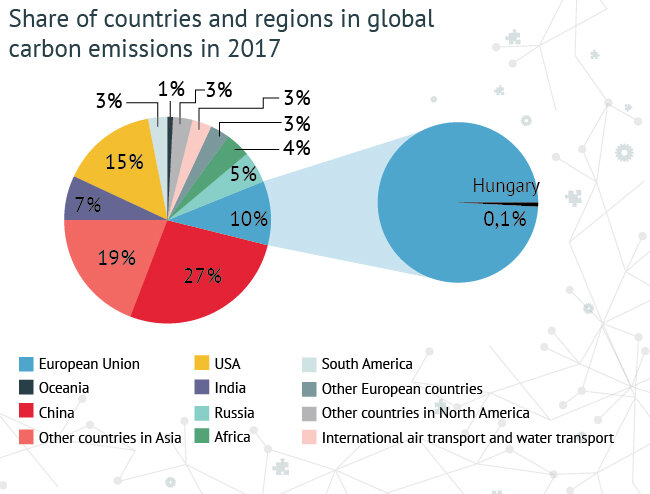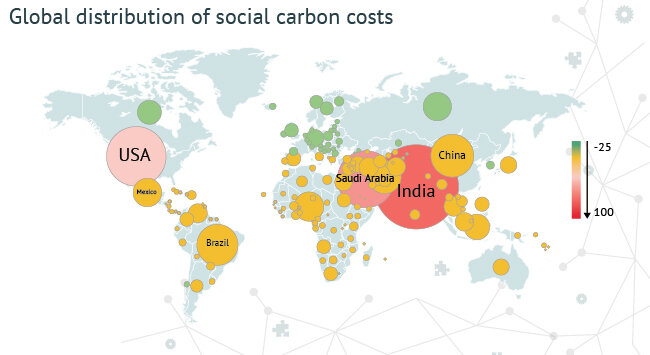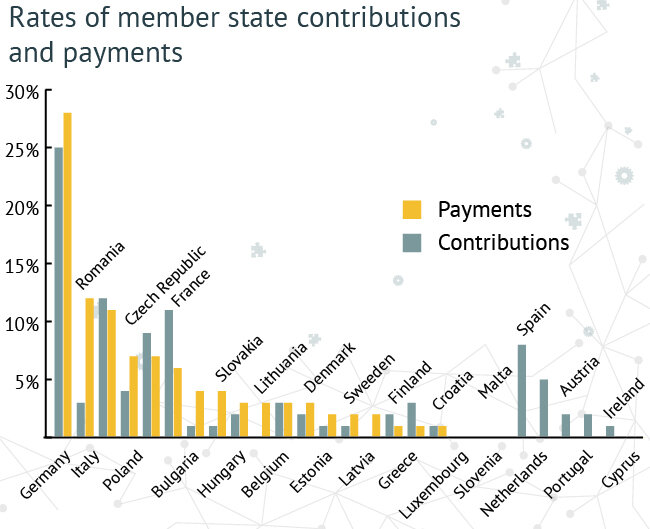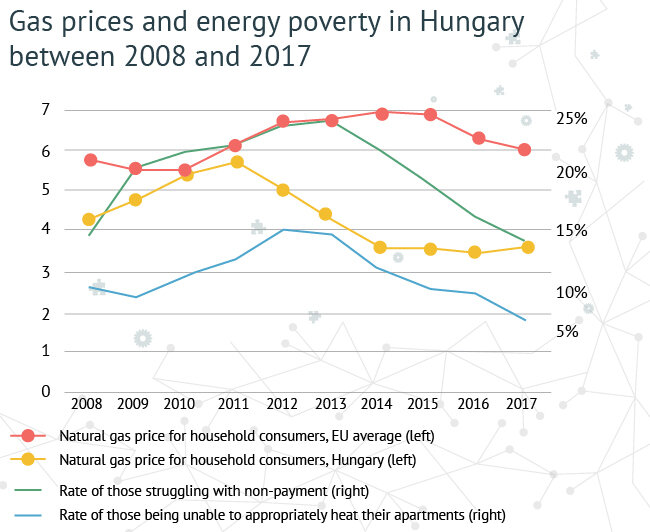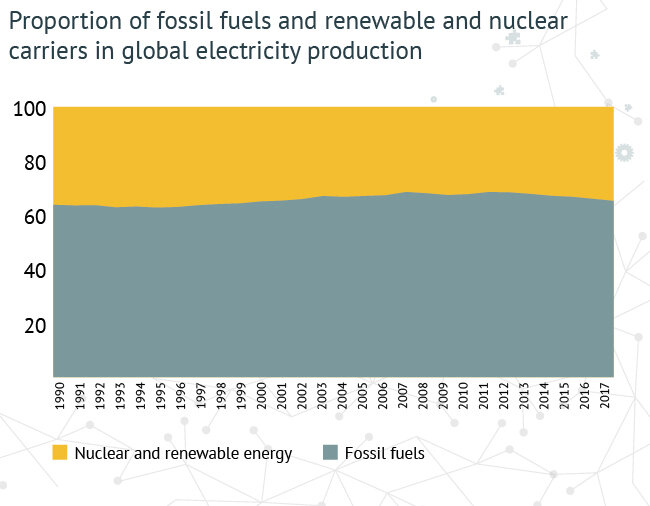Executive Summary
The aim of the European Green Deal is to be the first among the global mega-regions to achieve climate neutrality by 2050. The fight against climate change is expected to influence European citizens’ everyday life, and pose high costs on the member states, as well as on affected market actors. If the Commission is serious about the term “deal” in the title of the program, it must propose a fair and equitable strategy that is acceptable for all member states, not only the strong few. This policy document aims to present the principles of climate policy, the prevalence of which is necessary for each member state to bear the burden of implementation and for the Community to achieve its ambitious goals.
The document consists of three sections. Given the global nature of climate change, the significance of the ambitions of the European Union, including Hungary, can be primarily discussed in a global context.
Therefore, the first section of the document presents the EU’s emission and potential exposure position compared to other mega-regions. The section concludes that the EU’s climate policy must be rational, taking into consideration its moderate global responsibility and exposure so that it does not result in reducing the quality of its citizens’ life.
The second section focuses on rules of finance regarding the fight against climate change. Considering the matter of cost allocation, the future strategy has to respond to two key questions: on the one hand, how the basis for the contribution and payment rates of the co-financing mechanism in the member states is determined. On the other hand, how it ensures a fair burden-sharing between sectors by shaping the regulatory environment.
A common fund can be fair and motivating if contributions are based on the cumulated pollution of member states and payments are based on the performance of historic emission reduction. And in many cases, proportionate and equitable burden-sharing of the sectors can only be achieved through public intervention, therefore, reducing the ability of member states’ market regulation, in addition to sovereignty concerns, makes fair cost allocation impossible.
The third section shows that reducing the power of other member states, in addition to market regulation, may prove to be an additional barrier in the search of effective European climate policy. Since the ideal mitigation and adaptation strategies are different by member states, they cannot be standardized at the Community level. Technology is expected to play a significant, but by member states a different role in the fight against climate change. Therefore, the Commission should not support or prohibit a particular solution, but should allow the lowest emission and cheapest instruments that best fit the characteristics of the member state concerned.
Finally, the fourth section summarizes the five principles resulting from the lessons of the three previous sections, whose prevalence is the criterion of effective European climate policy. These principles are the following: principle of rationality, the polluter-pays principle, the principle of equity, the principle of sovereignty and the principle of technology neutrality.
The global climate position of the European Union
The European Union is not considered tovbe a significant mega-region, either as a cause of damage or as a victim of climate change caused by human activity. In 2017, the rate of absolute carbon emission in the European Union was only 9.8 percent, behind Asia that accounted for 53 percent and North America that accounted for 18 percent (Figure 1).
Figure 1
Source: [1]
There are significant global differences in per capita CO2 emissions: while in the United States, Australia and Canada the rates exceed 15 tons per year, many EU member states (such as France, Portugal or Hungary) are close to the global average of 4.8 tons. Like emissions, the country-level contribution to the social cost of carbon (CSCC) will be unevenly distributed: Asia (mainly India and China) and the United States will be most likely affected.
According to the study cited, the countries of the European Union will be among the countries suffering the least damage (Figure 2)1.
Figure 2
Source: [2]
Despite the EU’s low mitigation and adaptation weight, the Green Deal sets much more ambitious climate protection goals than other mega-regions, with limited justification regarding its historical responsibility (the European Union is responsible for only 22% of global cumulated atmospheric carbon emissions between 1751 and 2017 [1]). The effectiveness of the “role model” arising from time to time at the level of political communication, is highly questionable. On the other hand, environmental regulatory measures can cause significant market friction and thus, high economic costs, seriously undermining the international competitiveness of the Community [3].
In the future, the European Union must pursue an evidence-based and balanced climate policy, free from emotions and interests of political communication. The Community has to make the necessary sacrifices for the climate-neutral transition in line with its respective responsibility, however, its timing and effective implementation must be guided by the intent of maintaining the well-being and competitiveness of the region.
Allocation directives
Member states and economic sectors are responsible for emissions from the European Union to a different degree. According to the2018 statistics [4], 43.5% of the Community’s CO2 emissions were caused by the three largest pollutants, Germany (22.1%), the United Kingdom (11.6%) and Italy (9.8%). Former socialist countries accounted for only one-fifth of the total EU emissions, with Poland, the Czech Republic and Romania accounting for more than two-thirds. The role of the other eight former socialist countries, due to their small population and low carbon intensity, is insignificant: in Hungary, for example, per capita carbon dioxide emissions are only 5.4 tons (the seventh-lowest in the EU), accounting for only 1.4 percent of the total Community emissions. Multi-level allocation disputes have arisen from the area’s joint commitments and the costs involved.
• The first level is that to what extent each member state should bear the costs of transition;
• The second level is the logic of allocating the contribution to the member states.
• In addition to the allocation debate, a third-level discussion has developed on the EU single market, which focuses on the proportion of member states that can bear the costs of the transition.
1. The first level of the allocation debate
The polluter-pays principle has had the most significant impact on the development of the international environmental law, and it is, therefore, worth establishing an allocation mechanism between the member states. The principle is that the costs of repairing or preventing environmental damage must be borne by those who cause the damage. In the allocation debate on the member states’ common climate policy, this means that the costs of the transition to climate neutrality should be shared by the Member States in proportion to their historic carbon emissions. The initial year of cumulation is a matter of agreement, but due to the Kyoto Protocol and the availability of data, it is estimated for 1990 by this document.
2. The second level of the allocation debate
The second contentious point is the definition of the allocation logic for payments to countries. From a mitigation point of view, two – condition and process-based – approaches can becontrasted. According to the condition-based logic, the EU should support the current highcarbon areas, as their transition requires the biggest economic and social changes, and unit support is expected to be the most effective in these areas. In a process-based approach, the payment rate should be determined by the previous carbon-reduction performance. This document argues for the latter. The condition-based approach does not make actors interested in actually reducing their emissions, as the support is not for reduction, but for the current (and thus likely historic) high emissions. In this way, logic is also contrary to the polluter-pays principle because the sources are provided for the big polluters. In addition, the obliviousness of the guideline ignores the European Union’s more than twenty-year-old history of environmental policy and previous commitments of the member states, since it does not reward those who have effectively implemented (or over-performed) them, reducing the responsibility associated with the obligations.
In contrast, the process-based approach sees mitigation policy as a development path with a clear starting point (such as member state carbon emissions in 1990) and an endpoint (such as climate neutrality of member states in 2050), rewarding progress between the two. One of the advantages of this is that member states are interested in minimizing their pollution. On the other hand, it is worth noting that the unit social cost of reducing (or avoiding) carbon dioxide emissions increase with the amount saved. The most straightforward approach to the allocation of process- based payments is to allocate resources to each member state in proportion to its contribution to the reduction of European Union emissions between 1990 and 2017. According to the proposal provided in this document, countries that have increased their carbon dioxide emissions will not be paid.
The member state contribution rates calculated on the basis of cumulative CO2 emissions and the payment rates calculated on the basis of reduction performance are shown in Figure 3 (the United Kingdom is not included in the calculation due to its prospective exit).
Figure 3
Source: Own calculation based on [1]
As the largest emitter is Germany, it needs to contribute the highest proportion to climate protection costs, based on the polluter-pays principle. In the period under examination, however, the Germans also managed to achieve the largest absolute savings, so their payments, even if only to a small extent, were higher than their contributions. Romania has the highest payment rate compared to the contribution, which, with its large population and relatively low (3%) cumulated emission, achieved the third largest reduction in the period under examination. The mechanism is the most unfavorable for Spain, whose pollution increased by 20% during the period under examination, making it the fifth most polluted member state by 2017.
Corrective measures are possible for both contributions and payments. In the case of the former, for example, deducting the amount of carbon sequestrated in the territory of the member states from the carbon emission of the countries may be justified. In the case of the latter, if planning is not limited to the following year, or if decision-makers would like to have more robust results, it may be worth taking the average of the last few years instead of the current year (in this case the 2017 savings). In addition, the above allocation proposal is related to the mitigation measuresthat can be modified to meet the different adaptation needs of the countries. However,any correction that violates the polluter-pays principle and process-based allocation reduces the effectiveness and fairness of the system. Therefore, transferring contributions from other funds (such as cohesion funds or agricultural subsidies) or weighting payments according to different circumstances is an obstacle to the system and therefore unacceptable.
3. The third level of the allocation debate
The third contentious point stems from the fact that the European Union’s common rules on market liberalization leave the member states less and less room for manoeuvre to protect the end consumer from the costs of environmental interventions through official price regulation. This is especially true for high carbon-intensive products that are essential for life and difficult to replace: especially energy and basic food. The price elasticity of demand of these products is very low, which means that companies can easily pass on any new cost items to end consumers who, due to their vulnerability to products, have limited adaptability.
The need to prevent the exposure of the population is established by the polluter-pays principle, as population actors are directly responsible for only a small proportion of the emissions.
On the other hand, previous empirical studies have shown that people start to become sensitive to the issue of climate change only above a certain standard of welfare [5]. Accordingly, a decline in the
population’s standard of living could jeopardize the political legitimacy of the climate fight, both at member state and EU level.
From the transition burden point of view, the challenge posed by climate change in Hungary can be well compared with the changes in the gas prices for household consumers following the 2008 economic crisis. As a result of the European Union’s energy market regulation, the Hungarian government liberalized residential energy supply from 2008, eliminating official pricing. In the years following the new regulation, tariffs increased significantly beyond world market prices and the EU average. Households hit by the crisis in regard to their income were unable to adapt to price increases other than limiting their needs. Thus, in 2013, every fourth Hungarian household was unable to appropriately heat its property. The negative trend could be reversed because the government announced a price moratorium in 2010, reintroduced the official price setting in 2011 and started a major overhead cut from 2013 (Figure 4).
Figure 4
Source: Own calculation based on [6]
Market regulation in the European Union is increasingly orienting member states to dismantling state control. However, in the transition to climate neutrality, regulatory control is the only means of preventing market actors from fully passing on the costs to the population, thereby maintaining their margins and increasing the rate of the socially deprived.
It is, therefore, worth focusing on three main aspects when creating the financing and regulatory frameworks of the European Union’s common climate policy.
• For joint actions, the polluter-pays principle should be applied to member states’ contributions.
• Member states’ payments from the established fund should be determined by using a process-based approach and on the basis of performance.
• The costs of transition to climate neutrality should not be imposed on vulnerable residential customers, and this requires the maintenance of regulatory control.
Meeting all three conditions is a prerequisite for fair and equitable cost allocation.
National self-determination and technology competition
Subsidiarity, one of the most important principles of the European Union, is of paramount importance in climate policy. Although climate change is a global phenomenon, mitigation and adaptation solutions can be interpreted locally, and thus be used as a constructive basis for national and EU climate policy. Accordingly, common objectives can only be achieved through effective cooperation
between member states with different capabilities.
One of the most important tasks of common European climate policy is to find the optimum of legal harmonization and market integration, which, on the one hand, is capable of further strengthening the cohesion and advocacy capacity of the Community. On the other hand, it gives member states sufficient flexibility to be able to respond to changing circumstances in the technological and market environment, according to their potentials. The centralization of powers in Europe reduces the flexibility of member states’ adaptability, which can be particularly problematic in cases where major social and economic changes are needed. Moreover, the over-integration process is much harder to reverse than maintaining the legal status quo.
Under the umbrella of climate policy, the violation of sovereignty is particularly pronounced in energy policy. While the definition of a country’s energy mix is theoretically a member state competence, European rules are technologically differentiated, with a few exceptions, for example, they allow support for renewable but prohibit nuclear-based electricity production.
Therefore, while the fight against climate change should be aimed at reducing the rate of fossil fuels, their proportion has not substantially declined globally since 1990, despite an increase in renewable production (Figure 5).
Figure 5
Source: Own calculation based on [1]
Differentiation prevents competition between technologies based on cost and carbon intensity, thereby distorting the market and reducing efficiency. Technological differentiation should only be necessary for the security of supply reasons; however, this is a Member State competence heavily burdened by EU restrictions.
The emerging new European climate policy must not, therefore, violate the sovereignty of countries and differentiate their interventions on the basis of technology, but only on the basis of performance.
Summary of basic principles
This policy document aims to present key principles from national importance point of view for the development of new European climate policy. To summarize the findings, the following five principles can be formulated.
The principle of rationality. The principle of rationality is of general and horizontal nature. Henceforth, European climate policy should be shaped on the ground of reality, being aware of the position of the community, weighing the potential benefits and costs, and refraining from radicalism and exaggerations caused by political communication.
The polluter-pays principle. The polluter-pays principle should be followed in regard to financing the common climate policy and defining the sectoral burden of the measures, that is, the costs of reducing carbon emissions must be borne by the big polluters.
The principle of equity. The cost allocation of climate policy measures should be processed in an equitable manner so that they are not passed on to residential customers through the cost of food and energy necessary for living.
The principle of sovereignty. The European Union’s climate policy should be based on cooperation and agreements between member states and should not lead to diminishing the powers of nation-states.
The principle of technology neutrality. Climate protection measures should not differentiate according to technology but solely on the basis of performance.
Hungarian decision-makers should enforce these points in international negotiations, and international decision-makers should acknowledge them for the European Union to achieve its ambitious climate protection objectives.
Please find the full report here ->
Sources:
[1] Hannah Ritchie and Max Roser (2020) - „CO₂ and Greenhouse Gas Emissions”. Published online at OurWorldInData.org. Retrieved from: https://ourworldindata.org/co2-and-othergreenhouse-gas-emissions Utolsó megtekintés: 2020.01.20.
[2] Katharine Ricke; Laurent Drouet; Ken Caldeira; Massimo Tavoni. 2018. Country-level social cost of carbon. Nature Climate Change, vol. 8. pp. 895-900. https://doi.org/10.1038/s41558-018-0282-y
[3] Richard B. Steward. 1993. Environmental Regulation and International Competitiveness. The Yale Law Journal, vol. 102, no. 8., pp. 2039-2106. https://doi.org/10.2307/796859
[4] Eurostat, Air emissions accounts by NACE Rev. 2 activity. 2018.
[5] Marrhew J. Hornsey; Emily A. Harris; Paul G. Bain; Kelly S. Fielding. 2016. Meta-analyses of the determinants and outcomes of belief in climate change. Nature Climate Change, vol. 6, pp. 622-626. https://doi.org/10.1038/nclimate2943
[6] EU Energy poverty Observatory. URL: www.energypoverty.eu Utolsó megtekintés: 2020.01.21.
1. Negative CSCC values mean that the expected societal benefits of climate change (such as higher agricultural
productivity, lower heating needs, etc.) outweigh the costs in a given country.


